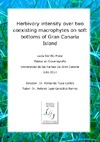Please use this identifier to cite or link to this item:
https://accedacris.ulpgc.es/handle/10553/12342
| DC Field | Value | Language |
|---|---|---|
| dc.contributor.advisor | González Ramos, Antonio Juan | - |
| dc.contributor.advisor | Tuya Cortés, Fernando José | - |
| dc.contributor.author | Río Moral, Lucía Del | - |
| dc.date.accessioned | 2014-10-21T02:30:37Z | - |
| dc.date.accessioned | 2018-05-15T10:55:22Z | - |
| dc.date.available | 2014-10-21T02:30:37Z | - |
| dc.date.available | 2018-05-15T10:55:22Z | - |
| dc.date.issued | 2014 | en_US |
| dc.identifier.uri | https://accedacris.ulpgc.es/handle/10553/12342 | - |
| dc.description.abstract | Seagrass meadows are highly productive and complex ecosystems delivering key ecosystem good and services. Typically, seagrasses are found on shallow-water soft bottoms interspersed with other macrophytes, e.g. green macroalgae. Herbivory over seagrasses has a larger influence than previously though and can contribute significantly to seagrass dynamics In this study, we aimed to assess whether the magnitude of herbivory differed between two coexisting macrophytes, the seagrass Cymodocea nodosa and the green seaweed Caulerpa prolifera on Gran Canaria Island. We focused on the impact of macrograzers over these two macrophytes during two seasons, and we combined outdoor experimentation (through direct and indirect approaches that estimated differences in the intensity of herbivory between both macrophytes) and indoor experimentation. Our results showed a significantly larger consumption of C. prolifera than C. nodosa. This fact notoriously contrasts with the classic idea that the genus Caulerpa contains chemical compounds, as caulerpenyne that deter herbivores. Fish abundance predicted the intensity of herbivory over C. nodosa leaves and C. prolifera fronds. Moreover, our results revealed that a physical feature of macrophytes (e.g. toughness) is a major driver of macro-herbivore feeding choices. | en_US |
| dc.format | application/pdf | es |
| dc.language | eng | en_US |
| dc.rights | by-nc-nd | es |
| dc.subject | 241705 Biología marina | en_US |
| dc.subject.other | Praderas marinas - Canarias | en_US |
| dc.subject.other | Ecosistemas marinos - Canarias | en_US |
| dc.title | Herbivory intensity over two coexisting macrophytes on soft bottoms of Gran Canaria Island | en_US |
| dc.type | info:eu-repo/semantics/masterThesis | en_US |
| dc.type | MasterThesis | en_US |
| dc.compliance.driver | 1 | es |
| dc.contributor.departamento | Biología | en_US |
| dc.contributor.facultad | Facultad de Ciencias del Mar | en_US |
| dc.identifier.absysnet | 702461 | es |
| dc.identifier.crisid | - | - |
| dc.investigacion | Ciencias | en_US |
| dc.rights.accessrights | info:eu-repo/semantics/openAccess | es |
| dc.type2 | Trabajo final de máster | en_US |
| dc.description.notas | Máster en Oceanografía ; 2013-2014 | en_US |
| dc.utils.revision | Sí | en_US |
| dc.identifier.matricula | TFT-29446 | es |
| dc.identifier.ulpgc | Sí | en_US |
| dc.contributor.buulpgc | BU-BAS | en_US |
| dc.contributor.titulacion | Máster Universitario en Oceanografía | es |
| item.fulltext | Con texto completo | - |
| item.grantfulltext | open | - |
| crisitem.advisor.dept | GIR ECOAQUA: Biodiversidad y Conservación | - |
| crisitem.advisor.dept | IU de Investigación en Acuicultura Sostenible y Ec | - |
| crisitem.advisor.dept | Departamento de Biología | - |
| crisitem.advisor.dept | GIR ECOAQUA: Biodiversidad y Conservación | - |
| crisitem.advisor.dept | IU de Investigación en Acuicultura Sostenible y Ec | - |
| crisitem.advisor.dept | Departamento de Biología | - |
| Appears in Collections: | Trabajo final de máster | |
Page view(s)
111
checked on Feb 22, 2025
Download(s)
52
checked on Feb 22, 2025
Google ScholarTM
Check
Share
Export metadata
Items in accedaCRIS are protected by copyright, with all rights reserved, unless otherwise indicated.
